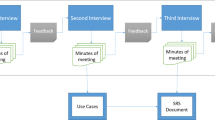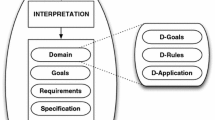Abstract
Context and Motivation: Customer-analyst interviews are among the most common techniques for eliciting requirements. However, students of computer science-related disciplines have little material and time for learning how to perform an effective interview. As a result, once out of the class, the effectiveness of analysts in interviewing highly depends on their experience. Question/problem: Since learning from failures is recognised as a wise strategy for professional improvement, this work aims at identifying communication mistakes of student requirements analysts. Principal idea/results: We conducted a case study involving 36 students to which we gave a typical introduction to requirements elicitation interviews. Then, we arranged and recorded 18 elicitation interviews involving the students. The interview recordings were analysed by interview experts. The experts produced a list of 9 main communication mistakes, which we report in this paper. Contribution: This is the first work that provides a concise list of mistakes of student analysts, with corrective recommendations and examples. It can be useful for instructors of software engineering courses, as well as for practitioners, who may commit the same mistakes of the students without being aware of it.
Access this chapter
Tax calculation will be finalised at checkout
Purchases are for personal use only
Similar content being viewed by others
References
Agarwal, R., Tanniru, M.R.: Knowledge acquisition using structured interviewing: an empirical investigation. JMIS 7(1), 123–140 (1990)
Anton, A.I.: Goal-based requirements analysis. In: RE 1996, pp. 136–144. IEEE (1996)
Aranda, A.M., Dieste, O., Juristo, N.: Effect of domain knowledge on elicitation effectiveness: an internally replicated controlled experiment. TSE 42(5), 427–451 (2016)
Argyris, C., Schon, D.A.: Theory in Practice: Increasing Professional Effectiveness. Jossey-Bass, Hoboken (1974)
Bubenko, J., Rolland, C., Loucopoulos, P., DeAntonellis, V.: Facilitating fuzzy to formal requirements modelling. In: RE 1994, pp. 154–157. IEEE (1994)
Chung, L., Nixon, B.A., Yu, E., Mylopoulos, J.: Non-functional Requirements in Software Engineering. Springer Science & Business Media, Berlin (2012)
Chung, L., Prado Leite, J.C.S.: On non-functional requirements in software engineering. In: Borgida, A.T., Chaudhri, V.K., Giorgini, P., Yu, E.S. (eds.) Conceptual Modeling: Foundations and Applications. LNCS, vol. 5600, pp. 363–379. Springer, Heidelberg (2009). doi:10.1007/978-3-642-02463-4_19
Coughlan, J., Macredie, R.D.: Effective communication in requirements elicitation: a comparison of methodologies. REJ 7(2), 47–60 (2002)
Davis, A., Dieste, O., Hickey, A., Juristo, N., Moreno, A.M.: Effectiveness of requirements elicitation techniques: empirical results derived from a systematic review. In: RE 2006, pp. 179–188. IEEE (2006)
Distanont, A., Haapasalo, H., Vaananen, M., Lehto, J.: The engagement between knowledge transfer and requirements engineering. IJKL 1(2), 131–156 (2012)
Ferrari, A., Spoletini, P., Gnesi, S.: Ambiguity and tacit knowledge in requirements elicitation interviews. REJ 21(3), 333–355 (2016)
Gabrysiak, G., Giese, H., Seibel, A., Neumann, S.: Teaching requirements engineering with virtual stakeholders without software engineering knowledge. In: REET 2010, pp. 36–45. IEEE (2010)
Gervasi, V., Gacitua, R., Rouncefield, M., Sawyer, P., Kof, L., Ma, L., Piwek, P., De Roeck, A., Willis, A., Yang, H., et al.: Unpacking tacit knowledge for requirements engineering. In: Maalej, W., Thurimella, A.K. (eds.) Managing Requirements Knowledge, pp. 23–47. Springer, Heidelberg (2013)
Hadar, I., Soffer, P., Kenzi, K.: The role of domain knowledge in requirements elicitation via interviews: an exploratory study. REJ 19(2), 143–159 (2014)
Hickey, A.M., Davis, A.M.: A unified model of requirements elicitation. J. Manag. Inf. Syst. 20(4), 65–84 (2004)
Mylopoulos, J., Chung, L., Nixon, B.: Representing and using nonfunctional requirements: a process-oriented approach. TSE 18(6), 483–497 (1992)
Niknafs, A., Berry, D.M.: An industrial case study of the impact of domain ignorance on the effectiveness of requirements idea generation during requirements elicitation. In: RE 2013, pp. 279–283. IEEE (2013)
Nuseibeh, B., Easterbrook, S.: Requirements engineering: a roadmap. In: FOSE 2000, pp. 35–46. ACM (2000)
Ouhbi, S., Idri, A., Fernández-Alemán, J.L., Toval, A.: Requirements engineering education: a systematic mapping study. REJ 20(2), 119–138 (2015)
Pacheco, C., Garcia, I.: A systematic literature review of stakeholder identification methods in requirements elicitation. JSS 85(9), 2171–2181 (2012)
Pitts, M.G., Browne, G.J.: Stopping behavior of systems analysts during information requirements elicitation. J. Manag. Inf. Syst. 21(1), 203–226 (2004)
Pitts, M.G., Browne, G.J.: Improving requirements elicitation: an empirical investigation of procedural prompts. Inf. Syst. J. 17(1), 89–110 (2007)
Portugal, S.: Interviewing Users: How to Uncover Compelling Details. Rosenfeld Media, Brooklyn (2013)
Regev, G., Gause, D.C., Wegmann, A.: Experiential learning approach for requirements engineering education. REJ 14(4), 269–287 (2009)
Robertson, S., Robertson, J.: Mastering the Requirements Process: Getting Requirements Right. Addison-Wesley, Boston (2012)
Rolland, C., Salinesi, C.: Supporting requirements elicitation through goal/scenario coupling. In: Borgida, A.T., Chaudhri, V.K., Giorgini, P., Yu, E.S. (eds.) Conceptual Modeling: Foundations and Applications. LNCS, vol. 5600, pp. 398–416. Springer, Heidelberg (2009). doi:10.1007/978-3-642-02463-4_21
Sharp, H., Rogers, Y., Preece, J.: Interaction Design: Beyond Human Computer Interaction, 4th edn. Wiley, Hoboken (2015)
Shuraida, S., Barki, H.: The influence of analyst communication in is projects. J. Assoc. Inf. Syst. 14(9), 482 (2013)
Sutcliffe, A., Sawyer, P.: Requirements elicitation: towards the unknown unknowns. In: RE 2013, pp. 92–104. IEEE (2013)
Svensson, R.B., Regnell, B.: Is role playing in requirements engineering education increasing learning outcome? REJ, 1–15 (2016). http://link.springer.com/article/10.1007/s00766-016-0248-4
Urquhart, C.: Exploring analyst-client communication: using grounded theory techniques to investigate interaction in informal requirements gathering. In: Lee, A.S., Liebenau, J., DeGross, J.I. (eds.) Information Systems and Qualitative Research, pp. 149–181. Springer, Heidelberg (1997)
Yu, E., Giorgini, P., Maiden, N., Mylopoulos, J.: Social modeling for requirements engineering: an introduction. Social Modeling for Requirements Engineering, pp. 3–10 (2011)
Zowghi, D., Coulin, C.: Requirements elicitation: a survey of techniques, approaches, and tools. In: Aurum, A., Wohlin, C. (eds.) Engineering and Managing Software Requirements, pp. 19–46. Springer, Heidelberg (2005)
Zowghi, D., Paryani, S.: Teaching requirements engineering through role playing: lessons learnt. In: RE 2003, pp. 233–241. IEEE (2003)
Author information
Authors and Affiliations
Corresponding author
Editor information
Editors and Affiliations
Rights and permissions
Copyright information
© 2017 Springer International Publishing AG
About this paper
Cite this paper
Donati, B., Ferrari, A., Spoletini, P., Gnesi, S. (2017). Common Mistakes of Student Analysts in Requirements Elicitation Interviews. In: Grünbacher, P., Perini, A. (eds) Requirements Engineering: Foundation for Software Quality. REFSQ 2017. Lecture Notes in Computer Science(), vol 10153. Springer, Cham. https://doi.org/10.1007/978-3-319-54045-0_11
Download citation
DOI: https://doi.org/10.1007/978-3-319-54045-0_11
Published:
Publisher Name: Springer, Cham
Print ISBN: 978-3-319-54044-3
Online ISBN: 978-3-319-54045-0
eBook Packages: Computer ScienceComputer Science (R0)




